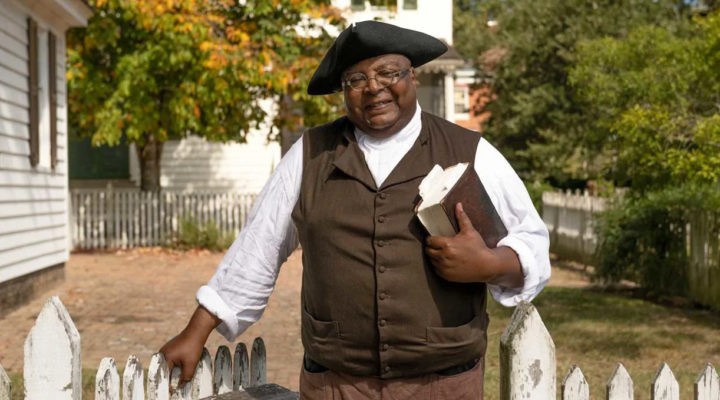Last week, when I left Williamsburg to drive to Peace Hill, my cousin’s farm in the next county, I could hear my uncle’s instructions over the phone during our first trip to Williamsburg in 1997.
“Take the road to Jamestown and then get on Highway 5 to cross the Chickahominy. After you cross the river, turn right at the first road you come to and drive until you pass the Baptist church, then watch for the red house with the gray roof on the left. That’s us.”
It was tricky just to find the road we were supposed to take through the woods and bottom lands along the river. Wilcox Neck Road is just a narrow opening in the woods, tall trees forming a canopy overhead. Eventually we passed Mount Zion Baptist Church, established in 1880, and we immediately started looking for the red house with the gray roof. We looked and we looked, and we were about to give up, when the road turned and there on the right was the Mount Pleasant Baptist Church where my cousin and his wife were married.
Sure enough, in a mile or two, we found my uncle’s house. How had he, who had driven this road countless times, miscounted the number of Baptist churches along the way?
He did not “see” Black Mount Zion. He only saw, he only counted, the white church; and it never occurred to him that we might see and count two churches.
He did not “see” Black Mount Zion. He only saw, he only counted, the white church; and it never occurred to him that we might see and count two churches.
That’s the problem. Too often we don’t “see.” We are blind to our Black neighbors and their history.
Romanticized Colonial Williamsburg
My husband and I fell in love with Colonial Williamsburg and returned repeatedly to explore this extraordinary historic area that starts in Jamestown, the earliest English settlement in America, and ends at Yorktown, where George Washington defeated Cornwallis and won the Revolutionary War.
In this idealized, romanticized and sanitized colonial town that W.A.R. Goodwin and John D. Rockefeller Jr. created almost 100 years ago, we rarely saw costumed Black interpreters or the quarters in which they lived, although they were 52% of the population at the time of the Revolution.
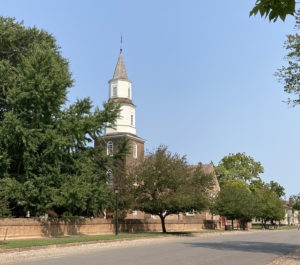
Bruton Parish Church at Colonial Williamsburg.
We saw elegant Bruton Parish Church, Church of England, where Washington and Jefferson and the royal governor worshiped; but we did not see the modest places where dissidents and Blacks gathered. Every other church in this historic district had been razed.
We saw a paved parking lot instead of the 1856 building where members of First Baptist Church worshiped for a century, until the Colonial Williamsburg Foundation tore down the old church building and built a new church outside the historic district for the Black congregation.
Discovering another Baptist church
I come from a family of First Baptist Church folks, so I wondered why my aunt and uncle didn’t join First Baptist Williamsburg when they moved to the area. But I never asked, and it never occurred to me that the church, with its handsome red brick, steepled building, might be a Black church.
In 1998, James Ingram began interpreting Gowan Pamphlet, an enslaved man whose ordination in 1772 was recorded by John Asplund (1761–1807), Baptist minister and statistician, in his Baptist Register, 1791–1794.
What originally was a loosely organized group of enslaved people gathering illegally under brush arbors on nearby plantations to listen to itinerate Black preachers emerged as a Baptist church led by a free Black man known only as Moses around 1776. Pamphlet is thought to have served alongside Moses and to have stepped in as pastor after Moses, repeatedly beaten for preaching under Virginia law, left the area in 1781.
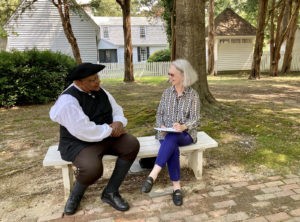
The author (right) interviewing James Ingram, who portrays Gowan Pamphlet at Colonial Williamsburg.
The records of the Virginia Dover Baptist Association and the writings of Robert Baylor Semple (1761–1831), Baptist minister, historian and long-time moderator of the association, confirm Pamphlet’s ministry, the inclusion of the church in the association — the first Black church to be granted membership — and the church’s size, which grew from about 200 to 500 by the time of Pamphlet’s death in 1809.
Changes at Colonial Williamsburg
I have returned to Williamsburg almost annually since my husband’s death in 2009; and each time I return, I see more Black interpreters and note increased efforts to tell the story of all colonial Virginians, not only those who lived in fine houses and worshiped at Bruton Parish.
Religious programing, including the important role that early Virginians played in securing religious liberty for all, has been prominent here as long as I have been visiting; and when the Baptist Joint Committee for Religious Liberty began its BJC Fellows program here, I cheered.
Amanda Tyler, BJC executive director, described the importance of the Fellows program: “The BJC Fellows program and its four-day seminar experience in Colonial Williamsburg has been pivotal to BJC’s learning about religious freedom and racial justice. Since the first inaugural group in 2015, 58 young professionals have gone through the BJC Fellows program and learned onsite with scholars, BJC staff and the historical interpreters in Colonial Williamsburg, including pastor James Ingram.
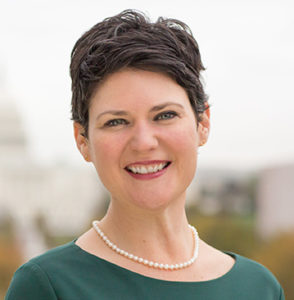
Amanda Tyler
“I have noticed the parallel journeys of BJC and Colonial Williamsburg — two predominantly white organizations that are grappling with our institutional histories as we work to make our missions and our communities more inclusive. Both our groups are acting intentionally to center the stories and perspectives of those that have been marginalized in the past. The impact of doing this work together in Colonial Williamsburg through our BJC Fellows program has been a richer, more impactful understanding of religious freedom for all that inspires the next generation of advocates to make a difference in their communities and contexts.”
To my surprise, though, an early African American participant in that program expressed her misgivings about coming to Williamsburg, which seemed to her to emphasize an affluent white society built on the backs of enslaved people.
Overcoming past perspectives
That perception is widely held and frequently expressed. In a 2020 interview, Virginia Matthews Harshaw, a member of First Baptist Church and president of the church’s Let Freedom Ring Foundation, said, “I remember getting dragged to Colonial Williamsburg in middle school for a field trip, but I didn’t see anybody that looked like me. I didn’t see anything that resembled me, except for the acknowledgement that slavery existed.”

Buildings along Duke of Gloucester Street in Colonial Williamsburg.
Ingram, 68, a native Virginian, confirmed that perspective. “Every child in Virginia, Black and white, makes a school trip to Colonial Williamsburg. And when you come, you see a white America. You don’t see anyone who looks like you.”
Given that widespread negative perception, I asked Ingram how he and other interpreters felt about portraying enslaved people.
“I consider it a badge of honor. We all do — a voice to the voiceless, a face to those who were seen just as property,” Ingram said.
He described how, when he speaks to an audience, he can see when the spark is ignited, when they can see: “It’s Phoenix rising out of the ashes of slavery.”
These days I often find myself quoting the Scottish poet Robert Burns:
O wad some Pow’r the giftie gie us;
To see oursels as ithers see us!
Colonial Williamsburg Foundation has asked itself that question, and its answer has been to redouble its efforts to tell a more complete story in partnership with First Baptist Church as it moves toward 2026 — the 250th anniversary of our nation and First Baptist Church and the 100th anniversary of Colonial Williamsburg. Most significant:
- If sufficient evidence can be found — as the archaeologists expect — Colonial Williamsburg will reconstruct the original church building with new educational and interpretive programing.
- Partnering with the University of William and Mary, the Bray School, thought to be the oldest school in America dedicated to teaching Black children, 1760–1874, will be relocated from the college campus to the historic district, renovated and opened by 2024.
- The American Indian Initiative will expand its staffing, programming and visibility.
Archaeology reinforms the experience

The archeological dig under way at the original site of First Baptist Church in Colonial Williamsburg.
Now, the parking lot has been ripped up, and the archaeologists are digging away as they locate the foundations of the 1856 church and the much smaller building that originally housed the congregation. By 2026, the intersection of Nassau and Francis streets no longer will be an out-of-the way detour but a major entry to the historic district.
Eager to see the site, I walked down the gravel path bordering Francis Street to Nassau Street, where the property is outlined and covered by blue and green plastic tarps. The site is identified as the location of the 1856 church, and across the street a reconstructed carriage house tells the story of the beginnings of First Baptist Church.
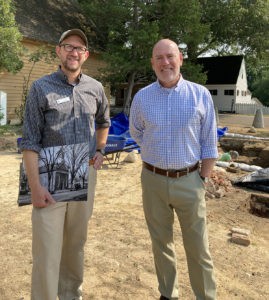
Jack Gary, director of archaeology at Colonial Williamsburg, and Ronald L. Hurst, vice president for museums, preservation and historic resources, standing at the site of excavation on the original First Baptist Church property.
Three days later, I met Ronald L. Hurst, vice president for museums, preservation and historic resources, and Jack Gary, director of archaeology, for a tour. Stacked red bricks mark the corners of the 1856 church, and the outline of the original building is marked by sandbags and protected by a blue tarp. The artifacts found under that foundation will date its age.
Behind the church, green tarps cover the unexpected discovery of graves. An early church cemetery? First Baptist Church and its members who are descendants of those early congregants will advise Colonial Williamsburg Foundation on how to handle the remains of those buried there.
Beyond the church site, the path turns to brick and leads to “main street” — Duke of Gloucester Street, stretching from the colonial Capitol building and past Bruton Parish Church to the 18th century campus of the College of William and Mary. Few who visit the historic district stray from Duke of Gloucester Street to see the stories and structures that lie beyond.
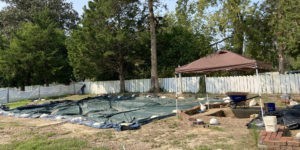
Green tarps cover graves discovered in the archeological dig under way at the original site of First Baptist Church in Colonial Williamsburg.
One could even argue that Nassau is not a historic street, for originally a deep, steep ravine crossed the area and bordered the church property. It was not prime real estate when a prosperous white store owner at the corner provided it to the church, and no doubt the large congregation overflowed the tiny original building and worshiped outdoors along the ravine, as it had at previous rural locations since the church’s inception.
But that will soon change. Nassau Street leads from Duke of Gloucester Street to the newly expanded Art Museums of Colonial Williamsburg, with a new archaeology center and visitors’ center to be constructed across the street before the 1776 celebration. New sidewalks will lead visitors past the “new” church, which will be the center of Black and religious programming at Colonial Williamsburg.
And maybe — just maybe — the hundreds of thousands of annual visitors will see and learn from a more accurate rendition of the American story.
Ella Wall Prichard is a journalism graduate of Baylor University who is known as a philanthropist and advisor to Baptist causes in Texas and beyond. She was a member of the Baylor Board of Regents and a director of the Baylor Alumni. Her book, Reclaiming Joy: A Primer for Widows, recounts the story of her husband’s untimely death and her suddenly finding herself the president of the family oil business. A longtime resident of Corpus Christi, Texas, her primary residence now is in Dallas, where she is a member of Wilshire Baptist Church.
Editor’s note: Next September, BNG will offer a three-day educational experience on the hidden history of racism with on-site events at Colonial Williamsburg and in Richmond, Va. The event originally was planned for this year but had to be rescheduled due to COVID. If you would like to be placed on an advance reservation list to get registration updates when they are available, please email Lindsay Bergstrom, BNG’s director of operations.

